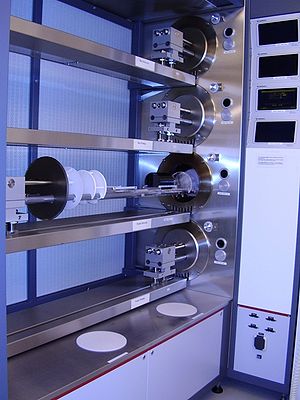Specific Process Knowledge/Thermal Process/A3 Phosphor Drive-in furnace
Feedback to this page: click here
This page is written by DTU Nanolab internal
Phosphorus Drive-in furnace (A3)
The Phosphorus Drive-in furnace (A3) is a Tempress horizontal furnace for thermal oxidation of silicon wafers. Furthermore, the furnace is used for phosphorus drive-in afte pre-deposition/doping or after boron ion implantation.
The furnace is mostly used for wet and dry thermal oxidation of silicon wafers. The oxidation recipes are named e.g. "WET1000" and "DRY1000", where "WET" or "DRY" indicates whether it is a wet or dry oxidation process, and the number indicates the oxidation temperature.
The purpose of phosphorus doping is to make conductive structures, etch stop layers etc. After a phosphorus pre-deposition/doping or ion implantation process, a drive-in process with or without an oxide growth is done in the furnace. The phosphorus pre-deposition is normally done in the Phosphorus Pre-dep (A4) furnace, and ion implantation have to be done elsewhere.
The Phosphorus Drive-in furnace is the third furnace tube in the A-stack positioned in cleanroom B-1. The furnaces in the A-stack are the cleanest of all furnaces in the cleanroom. Please be aware of that all wafers have to be RCA cleaned before they enter the furnace (except wafers coming form the Phosphorus Pre-dep furnace that have been BHF etched in the dedicated bath in the RCA bench), and please check the cross contamination information in LabManager, before you use the furnace.
The user manual, quality control instruction and results, technical information and contact information can be found in LabManager:
Phosphorus Drive-in furnace (A3)
Process knowledge
- Oxidation: look at the Oxidation page
- Phosphorus drive-in: look at the Dope with Phosphorus page
Quality Control - Recipe Parameters and Limits
| Quality Control (QC) for the processes "Wet1050" and "Dry1050" | ||||||||||||||||||||||||||
Numbers from March 2020 |
| Purpose |
|
Thermal oxidation:
Driving-in pre-deposited or ion-implanted phosphorus
|
|---|---|---|
| Performance | Film thickness |
|
| Process parameter range | Process Temperature |
|
| Process pressure |
| |
| Gasses on the system |
| |
| Substrates | Batch size |
|
| Substrate materials allowed |
|
